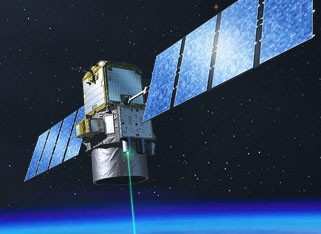Leak In Pressure Canister Required Early Switchover
 A space-borne lidar mission developed by NASA and the French
space agency Centre National d'Etudes Spatiales (CNES) has
successfully made the switch from its first laser to its back-up,
guaranteeing a continued stream of data that is allowing scientists
to better understand the complex roles clouds and aerosols play in
Earth's climate.
A space-borne lidar mission developed by NASA and the French
space agency Centre National d'Etudes Spatiales (CNES) has
successfully made the switch from its first laser to its back-up,
guaranteeing a continued stream of data that is allowing scientists
to better understand the complex roles clouds and aerosols play in
Earth's climate.
The extended data set will help capture the pattern of
year-to-year variations in cloudiness and the distribution of
elevated dust layers that have been difficult to predict in climate
models.
The Cloud-Aerosol Lidar and Infrared Pathfinder Satellite
Observations (CALIPSO) mission is now operating on its redundant
laser, which was designed as a contingency in case of a problem
with the primary laser. A slow pressure leak in the canister that
housed the primary laser, which the CALIPSO team had been aware of
since launch, made the switch necessary. The backup laser, which
stood ready for nearly three years, sent back its "first light"
image on March 12. The instrument is now operational and undergoing
a review of its calibration. The release of standard data products
from CALIPSO should resume in late April. Eventually data from
mid-March on will be processed and the total gap in data products
will be limited to about 10 days in early March.
CALIPSO makes unique vertical profile measurements of clouds and
aerosols. Aerosols are suspended particles from fires, industrial
activities and natural processes that are one of the least
understood weather and climate variables. CALIPSO's lidar
instrument measures the altitude and thickness of aerosol and cloud
layers in the atmosphere. It also measures particles' size, whether
they are spherical or non-spherical and whether they are composed
of water or ice. CALIPSO's observations complement data recorded by
four other satellites flying in formation called the A-Train, which
provide an unprecedented comprehensive global view of atmospheric
chemistry and composition within eight minutes of one another over
the same ground track.
First operational in June 2006, CALIPSO's primary laser
generated more than 1.6 billion pulses of light and 20 terabytes of
data that scientists from around the world are using to investigate
our global integrated Earth system. More importantly, the CALIPSO
data are giving scientists new insight into processes that control
how aerosols are formed and dispersed, how clouds form and
dissipate, and how aerosols and clouds interact.
 The CALIPSO team became aware before launch that the pressure
canister that housed the primary laser had a slow leak. The
decision to launch was made because it was expected the primary
laser could still complete the three-year prime mission. If it
could not, the back-up instrument could take over. Early this year
the laser showed unstable behavior consistent with low canister
pressure. An investigation determined that turning on the backup
laser now was the best solution.
The CALIPSO team became aware before launch that the pressure
canister that housed the primary laser had a slow leak. The
decision to launch was made because it was expected the primary
laser could still complete the three-year prime mission. If it
could not, the back-up instrument could take over. Early this year
the laser showed unstable behavior consistent with low canister
pressure. An investigation determined that turning on the backup
laser now was the best solution.
"We designed the system with the ability to change to a back-up
laser," said Chip Trepte, CALIPSO's project scientist at NASA's
Langley Research Center. Trepte compared building in the second
laser to carrying an extra flashlight on a long camping trip. Very
few lasers of the type used in CALIPSO had been flown in space
before. It was unknown how it would perform in the hostile space
environment. The back-up laser provided assurance that the mission
would meet its objectives.
"The good news is we turned on the second laser that had been
idle for three years, and it's working as well as the primary laser
did early in the mission," Trepte said. "The pressure in the second
laser canister is quite high, and it should be able to operate for
many more years."
Throughout the CALIPSO mission, NASA and CNES have worked
closely, from developing the mission, building the satellite
platform and integrating the payload to monitoring the instrument
and processing its valuable measurements.
CALIPSO is a joint effort between NASA and CNES. NASA and Ball
Aerospace designed the lidar instrument; CNES and Thales Alenia
Space, previously Alcatel Space, built the Proteus satellite
platform.
 Airbus Racer Helicopter Demonstrator First Flight Part of Clean Sky 2 Initiative
Airbus Racer Helicopter Demonstrator First Flight Part of Clean Sky 2 Initiative Diamond's Electric DA40 Finds Fans at Dübendorf
Diamond's Electric DA40 Finds Fans at Dübendorf ANN's Daily Aero-Term (04.23.24): Line Up And Wait (LUAW)
ANN's Daily Aero-Term (04.23.24): Line Up And Wait (LUAW) NTSB Final Report: Extra Flugzeugbau GMBH EA300/L
NTSB Final Report: Extra Flugzeugbau GMBH EA300/L Classic Aero-TV: 'Never Give Up' - Advice From Two of FedEx's Female Captains
Classic Aero-TV: 'Never Give Up' - Advice From Two of FedEx's Female Captains




